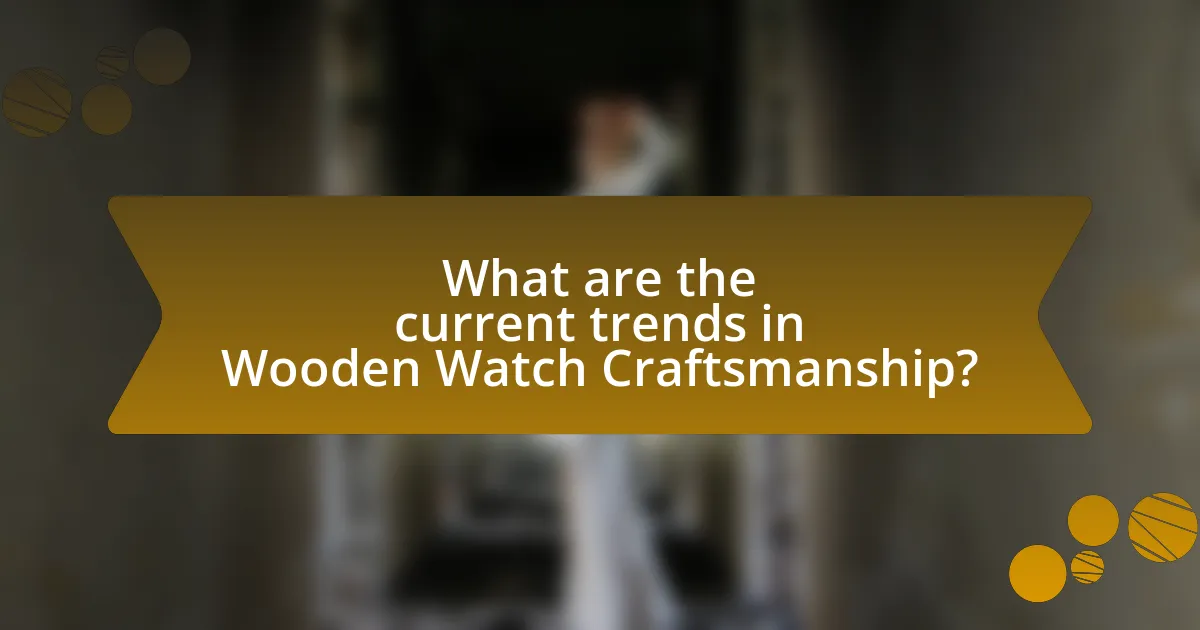The article focuses on sustainable wood sources for crafting watches, highlighting materials such as bamboo, reclaimed wood, and certified hardwoods from organizations like the Forest Stewardship Council (FSC). It emphasizes the importance of sustainability in the watchmaking industry, addressing the environmental impact of traditional practices and the benefits of responsible sourcing. Key topics include the characteristics of various wood types, ethical considerations in sourcing, certification processes, and the challenges faced by watchmakers in obtaining sustainable materials. Additionally, the article explores innovations in sustainable wood watchmaking and best practices for consumers when selecting wooden watches.

What are Sustainable Wood Sources for Crafting Watches?
Sustainable wood sources for crafting watches include bamboo, reclaimed wood, and certified hardwoods such as those from the Forest Stewardship Council (FSC). Bamboo is a fast-growing grass that can be harvested without damaging the ecosystem, making it an eco-friendly choice. Reclaimed wood, sourced from old buildings or furniture, reduces waste and minimizes the need for new timber. Certified hardwoods, like oak or maple, ensure that the wood is harvested sustainably, adhering to strict environmental standards. These sources contribute to responsible forestry practices and help preserve natural habitats.
Why is sustainability important in the watchmaking industry?
Sustainability is important in the watchmaking industry because it ensures the responsible sourcing of materials, particularly wood, which is essential for crafting high-quality timepieces. The watchmaking sector has a significant environmental impact, with traditional practices often leading to deforestation and depletion of natural resources. By prioritizing sustainable wood sources, brands can reduce their ecological footprint, promote biodiversity, and support ethical forestry practices. For instance, the Forest Stewardship Council (FSC) certification guarantees that wood used in watchmaking comes from responsibly managed forests, thereby reinforcing the industry’s commitment to sustainability and environmental stewardship.
How does the choice of wood impact environmental sustainability?
The choice of wood significantly impacts environmental sustainability by influencing deforestation rates, biodiversity, and carbon sequestration. Sustainable wood sourcing practices, such as selecting certified timber from responsibly managed forests, help mitigate deforestation and promote ecosystem health. For instance, the Forest Stewardship Council (FSC) certification ensures that wood is harvested in a way that maintains the forest’s biodiversity, productivity, and ecological processes. Additionally, using wood from fast-growing species can enhance carbon sequestration, as these trees absorb more CO2 during their growth cycle. Therefore, selecting wood based on sustainability criteria directly contributes to preserving natural resources and reducing environmental degradation.
What are the ethical considerations in sourcing wood for watches?
The ethical considerations in sourcing wood for watches include sustainability, legality, and social responsibility. Sustainable sourcing ensures that wood is harvested in a way that maintains ecological balance, preventing deforestation and habitat destruction. Legally sourced wood complies with regulations such as the Convention on International Trade in Endangered Species (CITES), which protects threatened species from over-exploitation. Social responsibility involves ensuring fair labor practices and respecting the rights of indigenous communities involved in the harvesting process. For instance, the Forest Stewardship Council (FSC) certification guarantees that wood products are sourced from responsibly managed forests, promoting environmental and social standards.
What types of wood are considered sustainable for watchmaking?
Sustainable wood types for watchmaking include bamboo, reclaimed wood, and certified hardwoods such as maple and walnut. Bamboo is a fast-growing grass that can be harvested without killing the plant, making it an eco-friendly choice. Reclaimed wood is sourced from old structures, reducing the need for new timber and minimizing waste. Certified hardwoods, which come from sustainably managed forests, ensure that the wood is harvested responsibly, adhering to standards set by organizations like the Forest Stewardship Council (FSC). These practices contribute to environmental conservation and promote sustainable sourcing in the watchmaking industry.
Which hardwoods are commonly used in sustainable watch crafting?
Common hardwoods used in sustainable watch crafting include maple, walnut, and cherry. These woods are favored for their durability, aesthetic appeal, and sustainable sourcing practices. Maple is known for its fine grain and light color, making it a popular choice for watch faces. Walnut offers a rich, dark hue and is often used for watch cases, while cherry is appreciated for its warm tones and ability to age beautifully. The sustainability of these hardwoods is supported by responsible forestry practices, ensuring that they are harvested in a manner that maintains ecological balance.
What are the characteristics of softwoods suitable for watches?
Softwoods suitable for watches typically exhibit characteristics such as lightweight, durability, and ease of machining. These properties make softwoods like pine, cedar, and spruce ideal for crafting watch cases and components. Lightweight softwoods reduce the overall weight of the watch, enhancing comfort for the wearer. Durability ensures that the wood can withstand daily wear and tear, while ease of machining allows for intricate designs and precise fittings, essential for watchmaking. Additionally, softwoods often have a fine grain and attractive appearance, contributing to the aesthetic appeal of the final product.
How are sustainable wood sources certified?
Sustainable wood sources are certified through established standards set by organizations such as the Forest Stewardship Council (FSC) and the Programme for the Endorsement of Forest Certification (PEFC). These organizations evaluate forestry practices to ensure they meet criteria for environmental sustainability, social responsibility, and economic viability. Certification involves rigorous assessments, including audits of forest management practices, traceability of wood products, and compliance with legal regulations. For instance, FSC certification requires adherence to principles that promote biodiversity conservation and the rights of indigenous peoples, ensuring that wood sourced is not only sustainable but also ethically harvested.
What organizations provide certification for sustainable wood sources?
Organizations that provide certification for sustainable wood sources include the Forest Stewardship Council (FSC) and the Programme for the Endorsement of Forest Certification (PEFC). The FSC certifies forests that are managed sustainably, ensuring environmental, social, and economic benefits, while the PEFC focuses on promoting sustainable forest management through independent third-party certification. Both organizations are recognized globally for their rigorous standards and contribute to responsible sourcing of wood products.
How does certification impact consumer trust in watch brands?
Certification significantly enhances consumer trust in watch brands by providing assurance of quality and ethical sourcing. When a watch brand is certified, it indicates adherence to specific standards, such as sustainability and responsible sourcing, which are increasingly important to consumers. For instance, certifications like the Forest Stewardship Council (FSC) guarantee that wood used in watchmaking comes from responsibly managed forests, thereby appealing to environmentally conscious buyers. Research shows that 66% of consumers are willing to pay more for products from brands committed to sustainability, highlighting the direct correlation between certification and consumer trust.

What are the benefits of using sustainable wood in watchmaking?
The benefits of using sustainable wood in watchmaking include environmental conservation, enhanced aesthetic appeal, and improved brand reputation. Sustainable wood sourcing helps preserve forests and biodiversity, as it promotes responsible harvesting practices that minimize ecological impact. Additionally, watches crafted from sustainable wood often feature unique grain patterns and colors, appealing to consumers seeking distinctive designs. Brands that prioritize sustainable materials can enhance their reputation, attracting environmentally conscious customers and potentially increasing sales. According to a study by the Forest Stewardship Council, sustainable forestry practices can lead to a 30% increase in forest health, demonstrating the positive impact of using sustainable wood in various industries, including watchmaking.
How does sustainable wood enhance the aesthetic appeal of watches?
Sustainable wood enhances the aesthetic appeal of watches by providing unique textures, colors, and patterns that are not found in synthetic materials. Each piece of sustainable wood, sourced from responsibly managed forests, showcases natural variations that contribute to the individuality of each watch, making them visually striking. For example, woods like ebony or bamboo can offer rich hues and intricate grain patterns, which add depth and character to the design. Additionally, the use of sustainable wood aligns with eco-conscious consumer preferences, further elevating the watch’s appeal by combining beauty with environmental responsibility.
What unique qualities do different wood types bring to watch design?
Different wood types bring distinct qualities to watch design, enhancing aesthetics, durability, and functionality. For instance, mahogany is known for its rich color and fine grain, providing a classic look, while bamboo is lightweight and eco-friendly, appealing to sustainability-conscious consumers. Teak offers natural water resistance and durability, making it suitable for outdoor watches. Additionally, walnut has a deep, warm tone that adds elegance, while maple is favored for its light color and smooth finish, allowing for intricate designs. These unique characteristics not only influence the visual appeal of the watches but also their longevity and user experience, making wood an attractive material in watchmaking.
How does the finish of wood affect the overall look of a watch?
The finish of wood significantly influences the overall look of a watch by enhancing its aesthetic appeal and highlighting the natural grain patterns. A high-quality finish can bring out the richness of the wood’s color, creating a more vibrant and visually striking appearance. For instance, a glossy finish can reflect light, adding depth and dimension, while a matte finish offers a more understated and sophisticated look. Additionally, different finishes can affect the texture, making the wood feel smoother or more rustic, which can align with the design intent of the watch. The choice of finish ultimately determines how the wood interacts with light and the viewer’s perception, thus playing a crucial role in the watch’s overall design and appeal.
What are the environmental benefits of using sustainable wood?
Sustainable wood provides significant environmental benefits, primarily by promoting forest conservation and reducing carbon emissions. When sourced sustainably, wood comes from forests that are managed to maintain biodiversity, protect ecosystems, and ensure that tree harvesting does not exceed growth rates. This management helps preserve habitats for wildlife and supports the overall health of the forest. Additionally, sustainable wood practices contribute to carbon sequestration, as trees absorb carbon dioxide during their growth, thus mitigating climate change. According to the Forest Stewardship Council, sustainably managed forests can store up to 1.1 billion tons of carbon annually, highlighting the critical role of sustainable wood in combating global warming.
How does sustainable wood sourcing contribute to forest conservation?
Sustainable wood sourcing contributes to forest conservation by ensuring that timber is harvested in a manner that maintains the ecological balance and health of forests. This practice involves selective logging, replanting, and adhering to certification standards that promote responsible forest management. For instance, the Forest Stewardship Council (FSC) certification guarantees that wood products come from responsibly managed forests that provide environmental, social, and economic benefits. By prioritizing sustainable sourcing, the demand for illegal logging decreases, which helps protect biodiversity and reduces deforestation rates. According to the World Resources Institute, sustainable forestry practices can lead to a 30% reduction in carbon emissions compared to conventional logging methods, further supporting forest conservation efforts.
What role does sustainable wood play in reducing carbon footprints?
Sustainable wood plays a crucial role in reducing carbon footprints by acting as a carbon sink, absorbing carbon dioxide from the atmosphere during its growth. This process helps mitigate climate change by sequestering carbon, which is essential for lowering overall greenhouse gas emissions. For instance, according to the Forest Stewardship Council, sustainably managed forests can store up to 1.1 billion tons of carbon annually, demonstrating the significant impact of responsible forestry practices on carbon reduction. Additionally, using sustainable wood in products like watches minimizes reliance on fossil fuels and promotes a circular economy, further contributing to lower carbon emissions.
How does using sustainable wood affect the watch’s durability?
Using sustainable wood can enhance a watch’s durability by providing a balance of strength and flexibility. Sustainable wood, often sourced from resilient tree species, tends to have natural oils and density that contribute to its longevity and resistance to wear. For instance, woods like teak and mahogany are known for their durability and ability to withstand environmental stressors, which can prolong the lifespan of the watch. Additionally, sustainable practices ensure that the wood is harvested responsibly, maintaining the integrity of the material and reducing the likelihood of defects that could compromise durability.
What factors influence the longevity of wooden watches?
The longevity of wooden watches is influenced by factors such as the type of wood used, the quality of craftsmanship, environmental conditions, and maintenance practices. Different wood species have varying levels of durability; for instance, hardwoods like teak and mahogany are more resistant to wear and moisture compared to softer woods. High-quality craftsmanship ensures proper sealing and finishing, which protects the wood from environmental damage. Additionally, exposure to extreme temperatures and humidity can adversely affect the wood, leading to warping or cracking. Regular maintenance, including cleaning and conditioning, can significantly extend the lifespan of wooden watches by preventing deterioration.
How do different wood treatments enhance durability?
Different wood treatments enhance durability by protecting the wood from moisture, pests, and decay. Treatments such as pressure treatment, which infuses preservatives into the wood, significantly increase resistance to rot and insect damage, extending the lifespan of the material. Additionally, finishes like varnishes and oils create a barrier that prevents water absorption, thereby reducing the risk of warping and splitting. Research indicates that treated wood can last up to five times longer than untreated wood in outdoor conditions, demonstrating the effectiveness of these treatments in enhancing durability.

What challenges do watchmakers face when sourcing sustainable wood?
Watchmakers face several challenges when sourcing sustainable wood, primarily related to availability, certification, and cost. The limited supply of certified sustainable wood species, such as mahogany or rosewood, restricts options for watchmakers. Additionally, obtaining certification from recognized organizations like the Forest Stewardship Council (FSC) can be a lengthy and complex process, complicating sourcing efforts. Furthermore, sustainable wood often comes at a higher price point, which can impact the overall cost of watch production and limit market competitiveness. These factors collectively hinder watchmakers’ ability to consistently incorporate sustainable wood into their products.
What are the logistical challenges in obtaining sustainable wood?
The logistical challenges in obtaining sustainable wood include transportation difficulties, supply chain inconsistencies, and regulatory compliance. Transportation issues arise due to the remote locations of sustainable forests, which can lead to increased costs and delays in delivery. Supply chain inconsistencies occur when sourcing wood from multiple certified suppliers, making it hard to ensure a steady and reliable supply. Regulatory compliance is another challenge, as obtaining the necessary certifications and adhering to environmental regulations can complicate the procurement process. These factors collectively hinder the efficient acquisition of sustainable wood for crafting watches.
How do supply chain issues affect the availability of sustainable wood?
Supply chain issues significantly reduce the availability of sustainable wood by disrupting the flow of raw materials from forests to manufacturers. These disruptions can arise from various factors such as transportation delays, regulatory changes, and increased demand for sustainable products. For instance, the COVID-19 pandemic caused widespread logistical challenges, leading to shortages in wood supplies, which directly impacted industries reliant on sustainable materials, including watchmaking. According to a report by the Food and Agriculture Organization, global wood supply chains are increasingly vulnerable to such disruptions, which can lead to higher prices and limited access to sustainably sourced wood.
What are the cost implications of using sustainable wood sources?
Using sustainable wood sources generally incurs higher costs compared to conventional wood due to factors such as certification processes, limited availability, and responsible harvesting practices. For instance, certified sustainable wood often requires adherence to strict environmental standards, which can increase production costs by 10% to 30%. Additionally, the sourcing of sustainable wood may involve longer supply chains and more rigorous quality controls, further contributing to elevated prices. These cost implications are balanced by the potential for enhanced brand value and consumer demand for eco-friendly products, which can lead to increased sales in markets prioritizing sustainability.
How do regulations impact the sourcing of sustainable wood?
Regulations significantly impact the sourcing of sustainable wood by establishing legal frameworks that ensure responsible forestry practices. These regulations, such as the Forest Stewardship Council (FSC) certification and the Lacey Act in the United States, mandate that wood products are sourced from sustainably managed forests, thereby promoting environmental conservation and biodiversity. Compliance with these regulations often requires thorough documentation and traceability of wood sources, which can enhance market access for sustainably sourced wood while discouraging illegal logging practices. For instance, the FSC certification process involves rigorous standards that assess the ecological, social, and economic aspects of forest management, ensuring that only wood from responsibly managed forests enters the market.
What laws govern the harvesting of wood for watchmaking?
The harvesting of wood for watchmaking is primarily governed by national and international forestry laws, including the Convention on International Trade in Endangered Species of Wild Fauna and Flora (CITES) and various national regulations that protect specific tree species. CITES regulates the trade of endangered species, ensuring that wood sourced for watchmaking does not contribute to the decline of these species. Additionally, countries like the United States and those in the European Union have their own forestry management laws that require sustainable practices, such as the Forest Stewardship Council (FSC) certification, which promotes responsible forest management. These laws collectively ensure that wood harvesting for watchmaking is conducted sustainably and ethically, preserving biodiversity and forest ecosystems.
How do international trade agreements affect sustainable wood sourcing?
International trade agreements significantly influence sustainable wood sourcing by establishing regulations that promote responsible forestry practices and trade. These agreements often include provisions that require participating countries to adhere to environmental standards, which can enhance the sustainability of wood products. For instance, the Forest Stewardship Council (FSC) certification, recognized in various trade agreements, ensures that wood is sourced from responsibly managed forests, thereby supporting sustainable practices. Additionally, trade agreements can facilitate access to markets for sustainably sourced wood, encouraging producers to adopt eco-friendly practices to meet international demand. This dynamic is evident in agreements like the Comprehensive and Progressive Agreement for Trans-Pacific Partnership (CPTPP), which emphasizes sustainable resource management among its member countries.
What innovations are emerging in sustainable wood watchmaking?
Innovations in sustainable wood watchmaking include the use of reclaimed wood, which reduces deforestation and promotes recycling of materials. Brands are increasingly sourcing wood from certified sustainable forests, ensuring that their materials are harvested responsibly. Additionally, advancements in eco-friendly finishes and treatments enhance the durability of wooden watches while minimizing environmental impact. For instance, some manufacturers are adopting water-based varnishes and natural oils that are less harmful than traditional chemical finishes. These practices not only contribute to sustainability but also appeal to environmentally conscious consumers, reflecting a growing trend in the luxury watch market towards ethical sourcing and production.
How are technology and craftsmanship evolving in this field?
Technology and craftsmanship in the field of crafting watches from sustainable wood sources are evolving through the integration of advanced manufacturing techniques and a renewed focus on artisanal skills. The use of computer-aided design (CAD) software allows artisans to create precise and intricate designs, enhancing the aesthetic appeal and functionality of wooden watches. Additionally, innovations in sustainable sourcing practices, such as certification programs for responsibly harvested wood, ensure that materials are both eco-friendly and high-quality. For instance, the Forest Stewardship Council (FSC) certification guarantees that wood comes from well-managed forests, supporting both environmental sustainability and craftsmanship integrity. This combination of technology and traditional skills is leading to a new era of watchmaking that prioritizes sustainability without compromising on quality or design.
What new materials are being explored alongside sustainable wood?
New materials being explored alongside sustainable wood include bamboo, recycled plastics, and bio-based composites. Bamboo is gaining attention due to its rapid growth and renewability, making it a sustainable alternative. Recycled plastics are being utilized to reduce waste and promote circular economy practices in watchmaking. Bio-based composites, which combine natural fibers with resins, offer durability and sustainability, appealing to eco-conscious consumers. These materials align with the growing demand for environmentally friendly options in the crafting of watches.
What best practices should consumers consider when choosing wooden watches?
Consumers should prioritize sustainability and craftsmanship when choosing wooden watches. Selecting watches made from sustainably sourced wood, such as FSC-certified materials, ensures that the wood is harvested responsibly, minimizing environmental impact. Additionally, examining the craftsmanship is crucial; high-quality wooden watches often feature durable finishes and precise movements, which enhance longevity and performance. Research indicates that well-crafted wooden watches can last for years, making them a worthwhile investment. Furthermore, consumers should consider the brand’s commitment to ethical practices, as companies that prioritize sustainability often provide transparency about their sourcing and manufacturing processes.




























